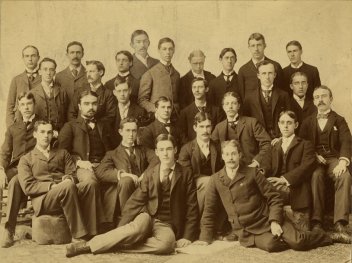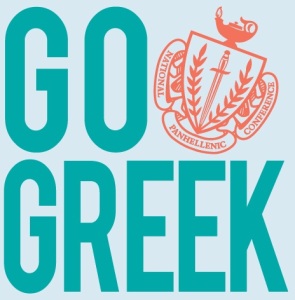The Roots
The history of Greek life is very rich and is extremely prevalent in American society; it has been known to make the college experience. Every active member of a fraternity or sorority has learned that there is much history to his or her chapter. The secrecies, philosophies, and traditions of each ‘house’ have a purpose and it is what sets every fraternity and sorority apart. A member is well aware of how their chapter came about. Members will study the school their house was founded and who were the first pioneers who laid down the rules and laws for the chapter. But have we ever asked the question of how sororities and fraternities even came about in the first place? Well, turning to history will answer the question of how the Greek system came to be in America. Looking at what a ‘fraternity’ or ‘sorority’ is, we learn that they come from the Latin words of frater and soror. These two words, meaning “brother” and “sister”, are what hold down the integrity of what these organizations are. Fraternities and sororities keep their integrity because of their brotherhood and sisterhood. Now although we got the name fraternity and sorority from the Latin language, we use Greek letters for a very important reason. In earlier founded chapters, their Greek letters were the initials of their motto. For example, the fraternity, Phi Beta Kappa (ΦΒΚ), has a motto that is three words. Each word starts with the Φ, Β, and Κ. The Phi Beta Kappa motto, “Φιλοσοφία Βίου Κυβερνήτης,” when translated into Latin, , means to us “Love of wisdom is the guide of life, and those Greek letters are what set the name for the chapter.
The First

The history of Greek affiliations in America dates back to the same year as the signing of the U.S. Constitution. But even before that, fraternities were a common part of the early 18th century colligate scene as expressed in the article History of Education Quarterly by G. Kurt Piehler. The early fellowships were mainly just for literate purposes, places to practice academics. It wasn’t till the chapter of Phi Beta Kappa at The College of William and Mary that separated themselves and chose to be different from the rest, starting a revelation. Once Phi Beta Kappa introduced themselves as an all male fraternity focusing on loyalty and brotherhood, the original literate societies started to decline. Frederick Rudolph explains in his novel, The American College and University: A History, that these societies saw a declination because the fraternities “created a higher level of loyalty and intruded new political complications into literary-society elections,”(145.). Phi Beta Kappa practiced the debate of politics in secrecy because it was highly frowned upon to do so publically during the early time of existence. To help understand why the they were heavily political based, the answer is found again in History of Education Quarterly that, “…the founders of Phi Beta Kappa conceived of their society as more than simply another literary society. Influenced by Masonic ideals, members were to think of each other as ‘unalienable Brothers’,” and he also reveals, “…members were required to take a vow of absolute secrecy concerning the rituals, symbols, and meetings of the society as a way of enforcing and highlighting fictive bonds of brotherhood,” (Piehler 210). A book by Robert Freke Gould, The History of Freemasonry: Its Antiques, Symbols, Constitutions, Customs, Etc., also reinforces the idea of how Masonic beliefs constructed the brotherhood behind a strong, secret, fraternity. Tradition is “derived from contemporary witnesses” (5). As members of a fraternity or sorority, tradition is what keeps the integrity and the practice of the tradition with its members was present with the Freemasons. Their secrecy with laws and traditions of the Brotherhood have been kept and carried out to present day.
Then & Now
Phi Kappa Beta was a fraternity, containing only males. For a long time, sororities remained obsolete and the coalition of fellowship was only available to men. From the 19th century and on, to be a part of a fraternity was, “was regarded by most college students as the preeminent or hegemonic form of masculinity on college campuses, the standard by which all other college men were measured,”(Syrett 3). By being labeled “Greek”, one was assumed to be smart, athletic, and masculine. Being apart of a fraternity also heightened the college experience. In Fredrick Rudolph’s The America College and University: A History. Shortly after the first fraternity came about, so did the first sorority and together these fellowships have forever changed the American college experience for all. Today, there are over 5,000 sorority and fraternity chapters across the United States. The members of these fellowships are a part of one large melting pot. Appreciation of the different ethnicities, sexualities, and diversities is what Gregory Parks and Craig L. Torbenson stress in the book Brothers and Sisters: Diversity in College Fraternities and Sororities (11). Evaluating the history of Greek life has helped us understand their traditions, importance to a community, and their growth overtime. Today chapters flourish in diversity, philanthropy, and their original traditions set by their founders and important figures of their fellowship. The history of Greek life is very deep and plentiful, but there is still history to be made by these outstanding organizations. For more information on just what all Greeks are doing, visit http://thefraternityadvisor.com/greek-life-statistics/
Gould, R. (1884). The Antiques of Freemasonry. In The history of freemasonry, its antiquities, symbols, constitutions, customs, etc., derived from official sources throughout the world. (p. 5). New York: J.C. Yorston &.
Piehler, G. (1988). Phi Beta Kappa: The Invention of an Academic Tradition. History of Education Quarterly, 28(2), 145-145.
Rudolph, F. (1962). The Extracurriculum. In The American college and university, a history. (p. 145). New York: Alferd. A. Knopf.
Syrett, N. (2009). Introduction. In The company he keeps a history of white college fraternities (p. 3). Chapel Hill: University of North Carolina Press.
Torbenson, C. (2009). Preface. In Brothers and sisters: Diversity in college fraternities and sororities (p. 11). Madison [N.J.: Fairleigh Dickinson University Press.
…So what?
History is an important lesson in anything you are apart of. Understanding the background of something’s past, will help you to determine its future. Knowing why fraternities and sororities became apart of higher education learning, helps us recognize its importance and traditions still practiced today. Also, a lot of this information is pretty neat. Who knew the first frat was found in the year of the signing of the constitution? God Bless America.

